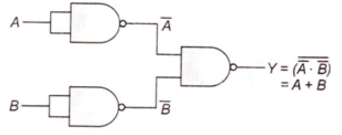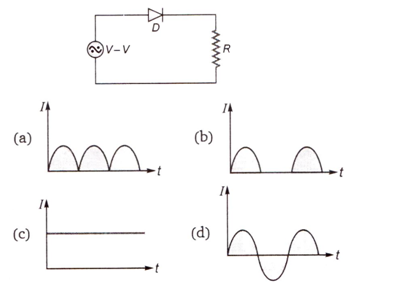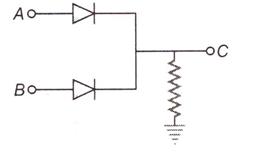11th And 12th > Physics
SEMICONDUCTORS MCQs
:
B
The given circuit works is half wave rectifier. In this circuit, we will get current through R when p-n junction diode is forward biased and no current when p-n junction is reversed biased. Thus the current through resistance will be shown by graph (b).
:
A
The output of OR gate is
Y’ = (A + B)
The output and AND gate is
Y = Y’ . C = (A + B) . C
If A = 1, B = 0, C = 1, they Y = (1 + 0). 1 = 1
:
D
Option (d)
At the barrier, there are electron concentration on p side.
:
C
When a diode is reverse biased, then the applied voltage supports the barrier voltage. Due to it, the reverse current is weak. It will be identical in two diodes.
:
A
Output of first NAND gate is, Y′=¯¯¯¯¯¯¯¯¯¯¯A.B
Output of second NAND gate is,
Y=¯¯¯¯Y′=¯¯¯¯¯¯¯¯¯¯¯¯¯¯¯¯¯¯¯¯¯¯A.B=A.B
Thus AND gate is formed.
:
B
Ib=Ie−Ic = 5.60 - 5.488 = 0.112 mA
β=IeIb=5.4880.112 = 49.
:
A
The circuit represents OR gate, as the output at C is 1, when either A or B or both A and B have input at level 1. But output at C is zero, when both A and B are at zero level and the Boolean expression is C = (A + B).
:
D
In the given circuit, junction diode D1 if forward biased, will conduct current and junction diode D2 is reverse biased, will not conduct current. Therefore, current
I = 210+15 = 0.08 A = 80 mA.
A working transistor with its three legs marked P, Q and R is tested using a multi-meter. No conduction is found between P and Q. By connecting the common (negative) terminal of the multimeter to R and the other (positive) terminal to P or Q, some resistance is seen on the multi-meter. Which of the following is true for the transistor?
:
B
When a multimeter is connected between P and Q there is no conduction between P and Q, then P and Q are of same type of semiconductor, ie, either both are on n-type or of p-type. It means emitter and collector of a transistor are P and Q. When R is connected to negative terminal of multimeter and positive terminal to P or Q, then emitter-base junction will conduct to some extent due to reverse biasing.
The similar is the case of collector – base junction. Thus the transistor is n-p-n transistor with R as base.






















